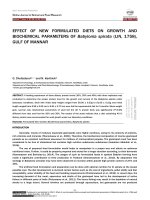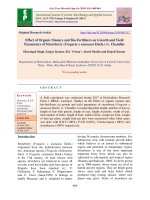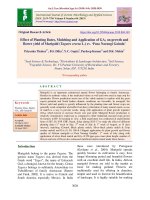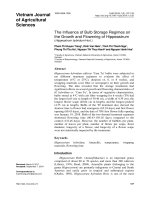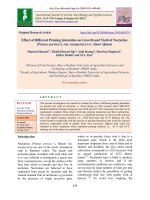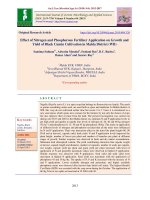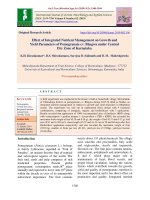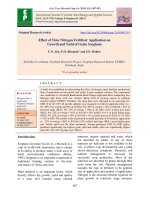Effect of biofertilizers applications on growth and flowering of african marigold cv. ‘Pusa Narangi Gainda’ during different season of the year under mid-hills conditions of himachal
Bạn đang xem bản rút gọn của tài liệu. Xem và tải ngay bản đầy đủ của tài liệu tại đây (363.77 KB, 7 trang )
Int.J.Curr.Microbiol.App.Sci (2019) 8(9): 234-240
International Journal of Current Microbiology and Applied Sciences
ISSN: 2319-7706 Volume 8 Number 09 (2019)
Journal homepage:
Original Research Article
/>
Effect of Biofertilizers Applications on Growth and Flowering of African
Marigold cv. ‘Pusa Narangi Gainda’ during Different Season of the Year
under Mid-Hills Conditions of Himachal Pradesh
Anju Kumari*, B.P. Sharma, Y.C. Gupta, Uday Sharma and Shweta Sharma
Department of Floriculture and Landscape Architecture
YS Parmar University of Horticulture and Forestry, Nauni, Solan (HP)- 173230
*Corresponding author
ABSTRACT
Keywords
Azotobacter, PSB
(phosphorus
solubilizing
bacteria), PGPR
(plant growth
promoting
rhizobacteria), AM
(Arbuscular
mycorrhiza), NPK,
FYM and marigold
Article Info
Accepted:
15 July 2019
Available Online:
10 August 2019
The present investigation was carried out at the experimental farm of Department of
Floriculture and Landscape Architecture, Dr. Yashwant Singh Parmar University of
Horticulture and Forestry, Nauni, Solan, HP in the year of 2016-2017 during different
season (rainy season and summer season) and pooled data of both the season experiment
were taken. The experiment was laid out in randomized block design replicated thrice and
with 10 treatments. The treatments comprised of N 2 fixer (Azotobacter), PSB (phosphorus
solublizing bacteria) PGPR (plant growth promoting rhizobacteria) and AM (Arbuscular
mycorrhiza) with the three levels of NPK 70%, 80% and 90% respectively. Pertaining data
exhibited growth and flowering parameters like highest plant height (72.48 cm), more leaf
area (75.40 cm2), higher plant spread (41.53 cm), more number of flowers per plant
(40.34) and longest flowering duration (47.44 days) in plants supplied with Azotobacter +
PSB + 70% RDF (T4). With regards to season, plant height, leaf area, plant spread, number
of flower per plant and flowering duration recorded to be more (70.76 cm, 78.91 cm2,
42.09 cm, 38.60 and 42.87 days, respectively) during summer season planting as compared
to rainy season planting while minimum number of days taken to bud appearance (53.04
days), minimum days taken to first flower opening (65.07 days) were observed with the
application of same treatment (T 4) during rainy season. Whereas, maximum weight of
individual flower (6.12 g) and largest flower diameter (5.85 cm) were recorded with
Azotobacter + PSB + 80% RDF (T 4) during rainy season. Lowest values of growth and
flowering traits were recorded in (T 1) control treated plants.
Introduction
Marigold (Tagetes erecta L.) is one of the
most specially grown loose flower crop which
belongs to family Asteraceae. Marigold has
been named after ‘Virgin Mary’. The king
Curtez after conquering Mexico got fascinated
by the beauty of marigold flowers and he
carried it to Spain. It was then offered to the
‘attar’ of Virgin Mary and thus got its name
Mary’s gold which is now popularly known as
marigold (Marshal, 1969). It is also known as
234
Int.J.Curr.Microbiol.App.Sci (2019) 8(9): 234-240
friendship flower in United States and student
lumen (student’s flower) in Germany. It
spreads to different regions of world during
early parts of 16th century from Mexico
(Bailey,1963). It occupies prominent position
among the traditional loose flowers grown in
India and ranks next only to jasmine in terms
of production. It is extensively being used in
religious and social occasions viz. to decorate
the marriage homes, restaurant, temples,
receptions, farewells, birthday occasions,
wedding ceremonies and various public and
social events. Its gaining popularity on
aacount of its easy culture, wide adaptibilty,
and increasing demand in the Asian
subcontinent. Sometimes, the whole plant is
used for decorations. It can be planted in beds
for mass display, in mixed borders and can
also be grown in pots In India, about 278
thousand hectares area is presently under
floriculture with a production of 1656
thousand MT loose flowers annually. The total
area under marigold is 55.89 thousand
hectares with a production of about 511.31
thousand MT (NHB 2016-2017).
The chemical fertilizers are important sources
of nutrients but the indiscriminate use of
chemical fertilizers poses the threat of
environmental pollution and soil health
degradation. At present, we are not in a
position to abandon the use of chemical
fertilizers completely, so the best option
available is to use the biofertilizers in lesser
amounts.
Thus,
integrated
nutrient
management is a strategy for advocating
judicious and efficient use of chemical with
matching addition of organic manures and
biofertilizers. Therefore, emphasis is now
focused on the use of organic manures such as
farm yard manure, and bio-fertilizers like
Azotobacter, Phosphate Solubilising Bacteria
(PSB), AM fungi and PGPR (Plant Growth
Promoting Rhizobacteria). Azotobacter is a
non symbiotic bacterium which fixes
atmospheric nitrogen in to soil (Somani,
2005). Phosphate solublizing organism are not
only able to solubilize insoluble forms of
inorganic P but are also capable to mineralize
organic forms of P, thus improving the
availability of native soil P. Keeping the above
facts in view, the present investigation was
conducted with the objectives of to see the
effect of biofertlizers and its combinations and
to find out appropriate dose of biofertilizers on
growth and flowering parameters of African
marigold respectively.
Materials and Methods
The present investigation was conducted at the
at the experimental farm of Department of
Floriculture and Landscape Architecture, Dr.
Yashwant Singh Parmar University of
Horticulture and Forestry, Nauni, Solan, HP in
the year of 2016-2017 to study the effect of
biofertilizers on growth and flowering of
African marigold and data of both season were
taken during 2016-2017. African marigold cv.
‘Pusa Narangi Gainda’ was planted during
different season viz, rainy season and summer
season respectively with the spacing of 30 x30
cm and with 1x 1 m2 plot size. The experiment
was laid out in randomized block design
(Factorial) with three replication which
comprised 10 treatments viz, T1 100% NPK of
RDF), T2 Azotobacter+PSB+90% (RDF), T3
Azotobacter+PSB+80%
(RDF),
T4
Azotobacter+PSB+70%
(RDF),
T5
Azotobacter+AM+90%
(RDF),
T6
Azotobacter+AM+80%
(RDF),
T7
Azotobacter+AM+70%
(RDF),
T8
PGPR+90% (RDF), T9 PGPR+80% (RDF)
and T10 PGPR+70% (RDF). The data of both
seasons were analyzed statistically for
interpretation of results.
Results and Discussion
The data on growth parameters is presented in
Table 1 clearly indicated that highest plant
height (72.48 cm) over T1 (control) observed
with T4 (Azotobacter + PSB + 70% RDF).
235
Int.J.Curr.Microbiol.App.Sci (2019) 8(9): 234-240
More leaf area (75.40 cm2) observed in plants
supplied with T4 (Azotobacter + PSB + 70%
RDF) which found to be statistically at par
(73.59, and 73.59 cm2, respectively) with T3
(Azotobacter + PSB + 80%RDF) and T7
(Azotobacter + AM + 80% RDF). Which
might be attributed to the fact that the conjoint
application of Azotobacter and PSB along
with reduced dose of chemical fertilizers
would have increased the total beneficial
microbial population in the rhizosphere of the
plant roots which in turn resulted in an
increased leaf area by increasing the
availability of nutrients (P, K, Zn, Cu etc.) as
well as plant growth hormone production
(Kaushal, 2006 and Tilak, 1993). Maximum
plant spread (41.53 cm) to be recorded with
the application of T4 (Azotobacter + PSB +
70% RDF), whereas it was minimum (34.80
cm) in plants being grown with T4
(Azotobacter + PSB + 70% RDF) Which may
be due to increased cell multiplication and
elongation due to enhanced nutrient uptake by
plants following inoculated with Azotobacter
and PSB probably caused the increased plant
height. Similar result was found by Preethi et
al., (1999) in Edward rose; Ravindra et al.,
(2013) in China aster; Renukaradhaya (2006)
in Carnation. In respect of seasons, more plant
height (70.76 cm), highest leaf area (78.91
cm2) and maximum plant spread (42.09 cm)
were recorded during summer season planting
over rainy season planting. This is might be
due to the availability of congenial growing
conditions for growth of African marigold
during summer season and subsequently the
plants could put up more vegetative growth.
These results are in confirmation with These
results are in close to agreement with the
earlier work of Mohanty et al., (1993) in
African marigold; Dilta et al., (2007) in China
aster.
Perusal data from Table 2 indicates that earlier
days for bud appearance (53.04 days) noticed
with T4 (Azotobacter + PSB + 70% RDF),
while it was late (57.85 days) with (T1) 100%
NPK however, earliest days taken to first
flower opening (65.07 days) recorded with the
application of T4 (Azotobacter + PSB + 70%
RDF) while it was maximum (71.95 days) in
plants receiving T1 (100% NPK). This may be
ascribed to the easy uptake of nutrients and
simultaneous transport of growth promoting
substances like auxins, gibberellins, vitamins
and organic acids produced by biofertilizers to
the axillary buds resulting in earliness to reach
harvesting stage. Sheergojri et al., (2013)
observed minimum number of days taken for
full opening of flower with an application of
NPK along with Azotobacter inoculation in
dahlia. Similar result is in line with the
findings of Vasanthi (1994) in Jasmine;
Narashima Raju and Haripriya (2001) in
Crossandra
obtained
similar
findings
regarding days taken to bud appearance and
days taken to first flower opening.
Maximum number of flowers per plant (40.34)
to be recorded with the T4 (Azotobacter + PSB
+ 70% RDF) while it was minimum (29.12)
with T1 (100% NPK) The significant increase
in number of flowers might be attributed to
more leaf area which might have resulted in
production and accumulation of maximum
photosynthates, resulting into production of
more number of flowers. Further, these results
got support from Mittal et al., (2010) in
African marigold; Meshram et al., (2008) in
annual Chrysanthemum and Chougala et al.,
(2014) in double daisy.
It is clear from Table 3, maximum individual
flower weight (6.12 g) was observed with T3
(Azotobacter + PSB + 80% RDF), however, it
was minimum (4.21 g) in plants grown with
T1 (100% NPK). Amongst these treatments,
larger flower size (5.85 cm) observed with T3,
(Azotobacter + PSB + 80% RDF), while it
was smallest (4.35 cm) in plants supplied with
100% RDF of NPK (T1) which might be
attributed to that biofertilizers enhance the
236
Int.J.Curr.Microbiol.App.Sci (2019) 8(9): 234-240
level of auxins which divert the photo
assimilates to the developing flower buds,
resulting in increased petal number thereby,
increasing the individual flower weight and
flower diameter.
Table.1 Effect of biofertilizers on vegetative growth of African marigold during different
planting seasons
Treatments
100% NPK of RDF
T1
Azotobacter+PSB+90% (RDF)
T2
Azotobacter+PSB+80% (RDF)
T3
Azotobacter+PSB+70% (RDF)
T4
Azotobacter+AM+90% (RDF)
T5
Azotobacter+AM+80% (RDF)
T6
Azotobacter+AM+70% (RDF)
T7
PGPR+90% (RDF)
T8
PGPR+80% (RDF)
T9
PGPR+70% (RDF)
T10
Mean
CD0.05
Plant height (cm)
Rainy
Summer
Mean
Season
Season
50.60
65.18
57.89
60.80
70.65
65.73
64.50
72.71
68.61
67.10
77.86
72.48
59.20
70.38
64.79
64.00
71.94
67.97
64.80
72.72
68.76
52.90
68.44
60.67
57.50
69.16
63.33
56.70
68.58
62.64
59.80
70.76
65.28
Season
: 1.39
Treatments
: 3.10
SeasonxTreatments : 4.39
Leaf area (cm2)
Rainy
Summer
Mean
Season
Season
59.61
69.51
64.56
61.82
80.43
71.13
64.96
82.21
73.59
66.89
83.91
75.40
61.39
80.26
70.83
62.43
83.04
72.74
66.47
80.04
73.26
59.70
71.81
65.76
61.21
79.14
70.18
59.77
77.83
68.80
62.42
78.91
70.67
Season
: 1.62
Treatments
: 2.82
SeasonxTreatments : 3.99
Plant spread (cm)
Rainy
Summer
Mean
Season
Season
30.00
39.59
34.80
34.87
42.36
38.62
35.44
42.50
38.97
38.14
44.92
41.53
34.07
42.05
38.06
34.87
42.43
38.65
37.66
43.22
40.44
31.07
40.53
35.80
33.47
41.78
37.63
31.20
41.50
36.35
34.10
42.09
38.09
Season
: 0.62
Treatments
: 1.40
Season xTreatments : 1.99
Table.2 Effect of biofertilizers on flowering attributes of African marigold during different
planting seasons
Treatments
T1
T2
T3
T4
T5
T6
T7
T8
T9
T10
Mean
CD0.05
100% NPK of RDF
Azotobacter+PSB+90%
(RDF)
Azotobacter+PSB+80%
(RDF)
Azotobacter+PSB+70%
(RDF)
Azotobacter+AM+90%
(RDF)
Azotobacter+AM+80%
(RDF)
Azotobacter+AM+70%
(RDF)
PGPR+90% (RDF)
PGPR+80% (RDF)
PGPR+70% (RDF)
Number of days taken to
bud formation (days)
Rainy
Summer
Mean
Season
Season
54.50
61.20
57.85
51.60
56.53
54.07
Days taken to first flower
opening (days)
Rainy
Summer
Mean
Season
Season
67.13
76.76
71.95
63.20
70.20
66.70
Number of flowers per plant
Rainy
Season
24.07
26.67
Summer
Season
34.17
39.35
Mean
29.12
33.01
51.10
55.58
53.45
63.60
69.13
66.37
32.47
41.20
36.84
49.80
55.87
53.04
62.13
68.00
65.07
37.20
43.47
40.34
51.70
56.80
54.25
64.73
70.67
67.70
25.27
37.76
31.52
50.20
56.47
53.14
63.07
68.20
65.64
27.80
40.79
34.30
51.20
56.47
53.84
63.20
69.95
66.58
35.07
42.97
39.02
53.00
58.53
55.77
51.90
58.13
55.02
52.40
58.47
55.44
51.74
57.43
54.59
Season
: 0.23
Treatments
: 0.51
Season x Treatments : 0.72
237
66.07
74.13
70.10
65.13
71.33
68.23
65.80
74.00
69.90
64.41
71.24
67.83
Season
: 0.33
Treatments
: 0.74
Season x Treatments : 1.05
24.54
36.05
24.27
34.83
24.47
35.40
28.18
38.60
Season
: 0.96
Treatments
: 2.14
Season x Treatments : 3.03
30.30
29.55
29.94
33.39
Int.J.Curr.Microbiol.App.Sci (2019) 8(9): 234-240
Table.3 Effect of biofertilizers on flowering parameters of African marigold during different
planting seasons
Treatments
Individual flower weight (g)
Rainy
Season
Summer
Season
Mean
Flower diameter (cm)
Rainy
Season
Summer
Season
Mean
Flower duration (days)
Rainy
Season
Summer
Season
Mean
T1
100% NPK of RDF
4.26
4.16
4.21
4.45
4.25
4.35
34.59
41.50
38.05
T2
Azotobacter+PSB+90%
(RDF)
5.02
4.80
4.91
5.23
4.80
5.02
36.21
48.02
42.12
T3
Azotobacter+PSB+80%
(RDF)
7.10
5.13
6.12
6.55
5.14
5.85
40.73
49.50
45.12
T4
Azotobacter+PSB+70%
(RDF)
6.04
5.54
5.79
5.50
5.25
5.38
42.07
52.81
47.44
T5
Azotobacter+AM+90%
(RDF)
5.57
4.93
5.25
5.47
4.88
5.18
35.95
47.47
41.71
T6
Azotobacter+AM+80%
(RDF)
4.93
4.68
4.81
5.07
4.76
4.92
38.91
48.10
43.51
T7
Azotobacter+AM+70%
(RDF)
6.47
5.39
5.93
5.91
5.20
5.56
41.39
51.78
46.59
T8
PGPR+90% (RDF)
4.26
4.22
4.24
4.76
4.16
4.46
35.87
47.29
41.58
T9
PGPR+80% (RDF)
4.85
4.40
4.63
4.97
4.64
4.67
35.40
43.93
39.67
T10
PGPR+70% (RDF)
4.72
4.43
4.58
4.85
4.65
4.75
35.65
47.11
41.38
5.32
4.77
5.05
5.28
4.82
5.01
37.68
42.87
40.28
Mean
CD0.05
Season
: 0.22
Treatments
: 0.48
Season x Treatments : 0.68
Season
: 0.12
Treatments
: 0.26
Season x Treatments : 0.37
The result are in agreement with the finding
of Dalawai and Naik (2014) in China aster.
With regards to season, earlier days for bud
appearance (51.74 days), minimum days
taken to first flower opening (64.41 days),
highest individual flower weight (5.32 g) and
largest flower diameter (5.28 cm) recorded
during rainy season as compared to summer
season. The reason might be that long day
conditions experienced by the summer season
planting produced more vegetative growth
and hence, flowering was delayed, whereas,
during August onwards, there were short day
conditions that resulted in the formation of
flower buds in lesser time period. These
results corroborate the findings of Singh and
Arora, (1988) and Samantaray et al., (1999)
who observed that apical flower- bud
Season
: 0.71
Treatments
: 1.59
Season x Treatments : 2.26
formation was hastened in marigold plants
when planted after September and before
March mainly due to short day conditions.
More individual flower weight and flower
diameter were noticed during rainy season
which might be attributed to moderate
temperature prevailing during the crop period
which is favorable for the production of
bigger size flowers in July planted crop.
These results are in close agreement with the
earlier findings of Dhawale et al., (2003) and
Kaushal et al., (2014) in China aster.
It was the discovered that maximum duration
of flowering (47.44 days) during 2016-2017
were recorded with T4 (Azotobacter + PSB +
70% RDF), however it was shortest (38.05)
with T1 (100% NPK). This result got support
238
Int.J.Curr.Microbiol.App.Sci (2019) 8(9): 234-240
from
Airadevi
(2012)
in
annual
Chrysanthemum who recorded maximum
flowering duration with Azospirillum + PSB
+ 50% vermicompost equivalent to
recommended dose of N + 50% NPK.
Further, Palagani et al., (2013) observed that
the plants receiving 75 per cent N + 75 per
cent P + 100 per cent K + vermicompost @
1.25 t/ha + cocopeat @ 0.875t/ha +
Azotobacter @ 2kg/ha + PSB @ 2kg/ha
resulted in maximum duration of flowering in
chrysanthemum (Chrysanthemum morifolium
Ramat). More number of flowers and longest
flowering duration was recorded during
summer season over rainy season. This might
be due to the reason that February- March
planted crop could have put more vegetative
growth that would have produced more
number of flower bud which ultimately
contributed for longest flowering duration in
African marigold. Chanda and Roychoudhary
(1991) reported the similar results in African
marigold.
opening (62.13 days) were observed during
rainy season planting when plants supplied
with T4 (Azotobacter + psb + 70% RDF).
Maximum individual flower weight (7.10 g)
and larger flower size (6.55 cm) were
obtained with the application of T3
(Azotobacter + PSB + 80% RDF) during
summer season planting.
References
Anonymous. 2016. National Horticulture Board.
Department of Agriculture and Cooperation,
Government of India. Retrieved from
www.nhb.gov.in.
Airadevi, A.P. 2012. Integrated nutrient
management
studies
in
garland
chrysanthemum
(Chrysanthemum
coronarium L.). Bioinfolet 9(4A): 430-434.
Bailey, L.H. 1963. The Standard encyclopedia of
Horticulture, III, McMillian Co. Ltd. New
York
Chanda, S and Roychaudhary, N. 1991. The
effect of planting dates and spacing on
growth, flowering and yield of African
marigold (Tagetes erecta L.) cv. ‘Siracole’.
The Horticulture Journal 4(2): 53-56.
Chougala, V., V.S. Patil., and Paramagoudar, P.
2014. Effect of integrated nutrient
management on yield and quality of double
daisy (Aster amellus L.). Trends in
Biosciences 7(14): 1820-1823.
Dalawai, B., and Naik H. 2014. Integrated
nutrient management studies in carnation
(Dianthus caryophyllus) cv. ‘Soto’ under
protected condition. International Journal of
Agricultural Sciences 2:2-24.
Dhawle, D.V., M.M. Dhamke and Panchbhai,
D.M. 2003. Effect of different planting
densities and season on flowering of China
aster. Journal of Maharashtra Agricultural
Universities 19(3): 349-352.
Dilta, B.S., Y.C. Gupta and Sharma, P. 2007.
Effect of different planting dates on
performance of China aster (Callistephus
chinensis Nees.). The Asian Journal of
Horticulture 2(2): 245-248.
Kaushal. S., B.S. Dilta, S.V.S. Chaudhary and
Gupta, Y.C. 2014. Effect of planting dates on
growth and flowering of China aster
Acknowledgments
I wish to acknowledge the timely help, full
co-operation
and
uninterrupted
encouragement of my parents, dear friends
and all the faculty member of the department
who helped me in every way willingly and
selfless.
Interaction effect
Interaction between season and treatments
revealed that plants grown during summer
season retained higher plant height (77.86
cm), highest plant spread (44.92 cm),
maximum leaf area (83.21 cm2), more number
of flower per plant 43.47) and longest
flowering duration (52.81 days) recorded with
the T4 (Azotobacter + PSB + 70 %RDF) when
the plants being grown during summer
season. Earlier days for bud formation (50.20
days) and minimum days for first flower
239
Int.J.Curr.Microbiol.App.Sci (2019) 8(9): 234-240
(Callistephus chinensis L.). International
Journal of Farm Sciences 4(1):60-71.
Kaushal, R. 2006. Use of Vriksha Mitra
biofertilizers on Apple. Project report,
Department of Soil Science and Water
Management, Dr YS Parmar University of
Horticulture and Forestry, Nauni, Solan,
India.
Marshal, C. 1969. Encyclopedia of Gardening.
Paul Hanyla, London. 20:2213-2214.
Meshram, N., S.Badge, S.A. Bhongle and
Khiratkar, S.D. 2008. Effect of bioinoculants with graded doses of NPK on
flowering, yield attributes and economics of
annual chrysanthemum. Journal of Soils and
Crops 18:217-220.
Mittal, R., H.C. Patel, D.D. Nayee and Sitapara,
H.H. 2010. Effect of integrated nutrient
management on growth and yield of African
marigold (Tagetes erecta L.) cv. ‘Local’. The
Asian Journal of Horticulture 5(2): 347-349.
Mohanty, C.R., T.K. Behera and Samantaray, D.
1993. Effect of planting time and spacing on
growth and flower yield of marigold cv.
‘African Yellow’. South Indian Horticulture
45(1/2): 41-44.
Narasimha, Raju S and Haripriya, K. 2001.
Integrated nutrient management in crossandra
(Crossandra infundibuliformis L.) cv.
Dindigul Local. South Indian Horticulture
49:181-184.
Preethi, T.L., C.M. Pappiah and Anbu, S. 1999.
Studies on the effect of Azosprillium sp.
nitrogen and ascorbic acid on the growth and
flowering of Edward rose (Rosa bourboniana
Desp.). South Indian Horticulture 47:106110.
Ravindra, P., M. Hanumanthappa, J.N. Hegde,
K.J. Maheshwar and Nagesha, L. 2013.
Effect of integrated nutrient management on
growth, yield and vase life of China aster
(Callistephus chinensis (L.) Nees) for coastal
Karnataka. Environment and Ecology
31:1104-1106.
Renukaradya, S., C.M. Pradeepkumar, H.M.
Santhosha, M. Dronachari and Shashikumar,
R.S. 2006. Effect of integrated system of
plant nutrition management on growth, yield
and flower quality of carnation (Dianthus
caryophyllus L.) under greenhouse. The
Asian Journal of Horticulture 6: 106-112.
Samantaray, D., C.R. Mohanty and Behera, T.K.
1999. Effect of planting time and spacing on
growth and flower yield of marigold (Tagetes
erecta L.) cv. ‘African Yellow’. Indian
Journal of Horticulture 56(4): 382-385.
Sheergojri, G.A., Z.A. Neelofar Rather, F.U.
Khan, I.T. Nazki and Qadri, Z.A. 2013.
Effect of chemical fertilizers and bioinoculants on growth and flowering of dahlia
(Dahlia variabilies Desf.) cv. ‘Pink
Attraction’. Applied Biological Research 15:
121-129.
Singh, J and Arora, J.S. 1988. Effect of planting
times and spacing on growth, flower and
seed production of marigold cv. ‘African
Giant Double Orange’. The Punjab
Vegetable Grower 23: 41-44.
Somani, L.L. 2005. Handbook of Biofertilizers.
Agrotech Publishing Academy, Udaipur.
1167p.
Tilak, K.V.B.R. 1993. In: Bacterial Fertilizers.
Indian Council of Agricultural Research,
Krishi Anusandhan Bhawan, Pusa, New
Delhi.
Vasanthi. 1994. Studies on the effect of graded
levels of nitrogen, phosphorus with
azospirillum and phosphobacteria on growth
and yield of jasmine cv. ‘jathimalli’ M.Sc.
Thesis. Tamil Nadu Agricultural University,
Coimbatore.
How to cite this article:
Anju Kumari, B.P. Sharma, Y.C. Gupta, Uday Sharma and Shweta Sharma. 2019. Effect of
Biofertilizers Applications on Growth and Flowering of African Marigold cv. ‘Pusa Narangi
Gainda’ during Different Season of the Year under Mid-Hills Conditions of Himachal Pradesh.
Int.J.Curr.Microbiol.App.Sci. 8(09): 234-240. doi: />
240
